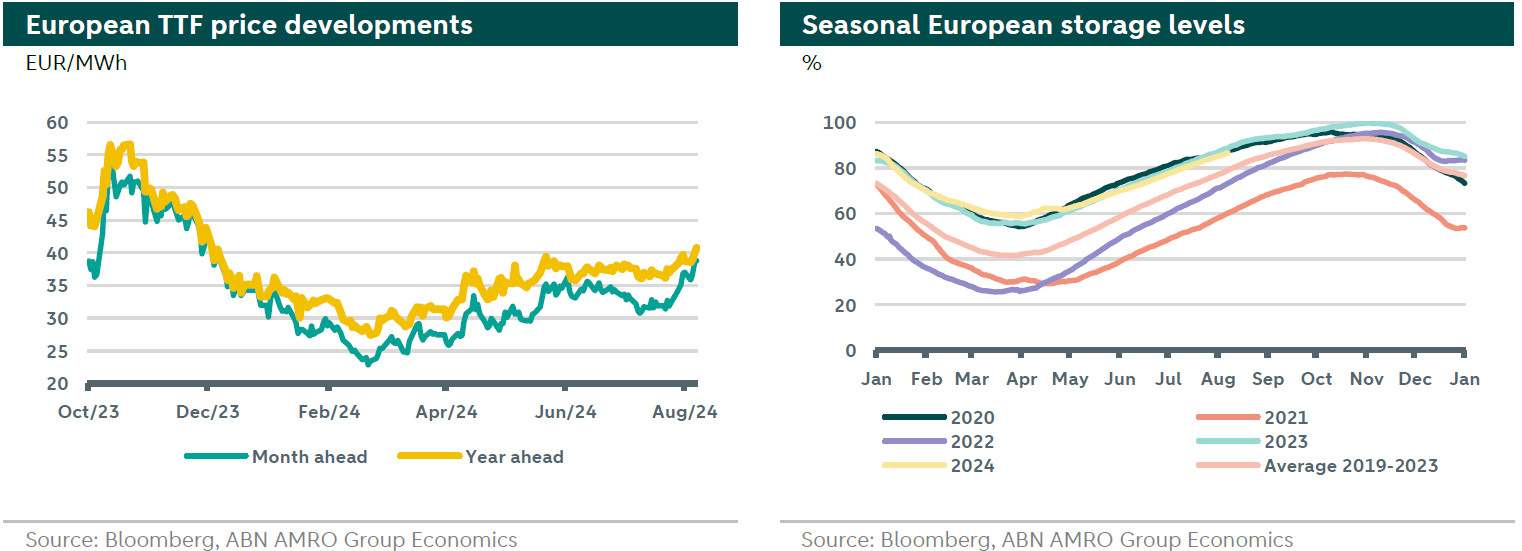Gas market update - Geopolitical uncertainty is back to be the main driver


European gas prices have been relatively stable in June and July, with an average of 37 €/MWh for the benchmark year-ahead contract (33.4 €/MWh for the month-ahead contract). Volatility in prices were mainly driven by the uncertainty of LNG supply. Relatedly, the resurgence of geopolitical tensions in the Middle East this week has increased fears of supply disruptions pushing the TTF price towards a nine-month high reaching 40 €/MWh for the year-ahead contract, as shown in the chart below (left). At the same time, worries about the US entering a recession, along with above-average storage levels have put a lid on prices.
The relative stability in TTF prices during the summer was disturbed by the rise of geopolitical uncertainty following the resurgence of tensions in the Middle East
Recovery in industrial demand is shifted forward as the manufacturing PMI is still in the contractionary territory
European gas storage levels are already at 86.5%, and Europe is heading to reach its strategic target well ahead the deadline in November providing some relief to the market
Our outlook for the year-ahead contract is to average around 35 €/MWh in Q3 and to end the year at 40 €/MWh
European gas market drivers
TTF gas prices witnessed a resurgence of the upward trend after a short-lived decline in June. This trend is driven by an increase in competition for the fuel from Asia and Egypt following heat waves and lower domestic gas production. Unplanned outage in Norway’s Nyhamna gas processing plant has also had participate in the upward push.
The mild winter in the last two years was one of the key factors that helped Europe to manage the energy crisis and allowed TTF prices to fall back down. However, weather forecasters are predicting that next Winter will be colder, which increases the importance that storage is filled on time. Currently, storage levels remain higher than average (around 86.5% at the time of writing) as illustrated in the chart above (right). With current levels, Europe is on track to meet its strategic target (90% by start of November) well ahead the start of the Winter.
New proposed European sanctions on transshipments of Russian LNG through the Union’s ports could affect prices downwards if the move caused some of the Russian gas to stay in the EU, as sending it away becomes more difficult.
From the demand side, the recovery in European industrial demand is slowing down as shown by a decline in the Eurozone composite PMI for July compared to that for June, which entered the stagnation territory (at 50.1, down from 50.9 in June). The index is mainly driven upward by the services PMI while the manufacturing PMI stayed far in contractionary territory at 45.6 (down from 45.8 in June). Weakness in output and demand, particularly in the German manufacturing sector is a main reason for this (see more ). Accordingly, recovery in industrial gas demand is shifted forward toward the end of 2024.
Geopolitical premium on TTF price is back following the resurgence of escalation between Iran and Israel after the assassination of Hamas political leader in Iran and a high military leader for Hezbollah in Lebanon by Israel. Iran vowed to revenge increasing the likelihood of a full-scale war scenario. Under such scenario, Israel’s gas exports are halted which would increase competition for global LNG by Egypt and Jordan. Furthermore, if the war spreads to Involve Iran directly, supplies from Qatar, one of the largest LNG suppliers to the EU, could be disrupted if trade in the strait of Hurmuz is somehow affected adversely, putting an upward pressure on TTF price.
Outlook
Looking forward, we expect the EU to reach its gas storage target by September, almost two months ahead its deadline. This would deliver some relief to the market and reduce price volatility in response to short-term shocks, such as heat waves or lower renewable output. However, emerging uncertainty following a more long-term supply disruptions, such as unplanned outages/ maintenance in Norway, would still take their toll on prices. Furthermore, we expect the increase in demand from a resurgence of industrial activity to gain momentum towards the end of 2024 and early 2025 following the expected cuts in interest rates. We further think that the tensions in the Middle East will be short-lived, and even in case of escalation, we think that disruptions in LNG supplies from Qatar has a low likelihood based on historical incidents in the strait of Hurmuz. Accordingly, our outlook for TTF year-ahead price is to average around 35 €/MWh (30 €/MWh for the month-ahead price) in Q3 of 2024. As we enter the heating season in the fourth quarter of 2024, we expect the recovery in industrial demand to start gaining momentum. Accordingly, we expect the year-ahead price to reach 40 €/MWh by year end.
